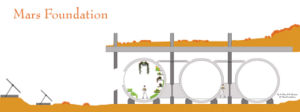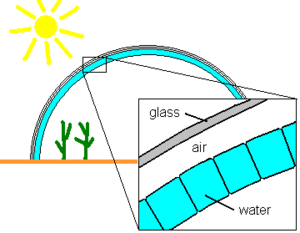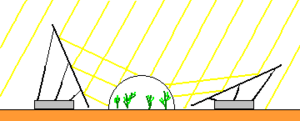Greenhouse

Growing plants in a Greenhouse delivers oxygen and food. It can play an important part in human recreation (Mars Garden) and may be the place for funerals. The sunlight is not bright enough on Mars to allow usual terrestrial plants to thrive, but it provides a valuable part of light energy for plants. Additional energy is necessary for lighting and heating.
The greenhouse will be constructed from transparent material, allowing maximum sunlight to pass, generating an artificial "greenhouse effect". The spectral properties of the material should be optimized to match the absorption characteristics of chlorophyll, maximizing the energy gain.
Plants need a mix of air pressure and temperature. The greenhouse must be strong enough to hold that air pressure, and it must be insulated to hold the temperature inside. Photosynthesis works only at fairly high temperatures.
Contents
Side-lit Greenhouse Concept

The Mars Foundation concept for a greenhouse involves the maximum use of local materials to avoid waste, maximize energy input and optimize space. Spawned from the Hillside settlement design, the greenhouse would most likely be located inside/next to a hill side (possibly in the location of Candor Chasma). Therefore regolith or some other absorbant material could be suspended above the greenhouse to protect occupants and plants from harmful radiation. The source of light would therefore be directed from the side, via an array of adjustable mirrors. A system of vents and ducts would allow warm air to circulate, perhaps even used to heat the main habitat.
I have just finished biundilg a solar room addition. When I put plants in it I will call it a greenhouse. A greenhouse of any style is an attempt to modify the environment. Glass or plastic walls and roof are often used because they allow sunlight to enter. Inside it becomes heat. There are a number of ways that heat is transfered. One way (radiant heat) is blocked by the glazing. This causes a greenhouse to heat up and even without plants an attached solar room can help heat the house it is attached to. The things needed to run a greenhouse are those things that are first necessary to maintain the environment and secondly are convenient for gardening. My uncle had a commercial greenhouse business. It had a huge boiler that used coal to create heat and send it to the greenhouses. They let most of the heat escape into the air. There was no air conditioning. A solar greenhouse will sometimes have double glazing to keep heat inside. As an alternative it may have insulation that is put in place at night to help keep the heat inside during cold months. The other important thing a solar greenhouse will have is a lot of thermal mass. This is often brick or stone walls inside of the insulated outer walls or lots of water in containers. The thermal mass soaks up extra heat and when the greenhouse is cool it releases heat to the inside. The effect is to keep the greenhouse from getting too hot or too cold. There are also greenhouse designs that use compost that is mixed in a way to heat up. This adds not only heat but can change the air mixture to something that plants will like even more than normal air.Most greenhouses will not have air conditioning to cool the air. Plants can usually tolerate a bigger range of temperatures than people can. Often there is a way to ventilate the greenhouse in the summer that may be sufficient to keep it cool enough. This is especially true if there is enough thermal mass. Plants and the ground around them give up a lot of water. If it gets too humid the structure may suffer. Again ventilation may be good enough. Additionally, there are ways to make the heat of the sun create a draft in a kind of solar chimney that will pull air like a fan through the rooms. Ventilation can be aided with vents that open automaticly without the use of electricity. Greenhouses are not all the same. If they are commercial they may be designed for a particular crop. Also the environment where they are built will make a difference. In a cold environment the growing season will be shorter and heating concerns will be greater. In a warm environment ventilation will be more important. In a dry environment keeping water vapor inside may also be a consideration. In a dark enviornment some consideration might be made about lighting. Once the inside environment is stable and sustainable some attention may be made to planting concerns: growing beds, soil, water supply and irrigation. In my greenhouse I just finished I have put a couple of potted plants but it is still freezing outside some nights. My next concern is to get some accurate idea of how the room is heating up compared to the outside temperatures. I have a thermostat for inside and outside but I have ordered one that I can hook up to the computer to log the temperature changes.
Water-shield Greenhouse Concept
Hydrogen does a good job absorbing cosmic radiation. Water contains highly concentrated hydrogen, and hence serves as a good radiation shield. On the other hand it is highly transparent for visible light and UV. The combination of both makes it an interesting material for greenhouse shielding.
Under a strong pressure resistent housing the water is placed in a thick layer. It absorbes the dangerous parts of cosmic radiation and sunlight and passes most of the spectral parts needed by humans and plants. Additionally, it helps to buffer daily temperature variations because of its high specific heat capacity.
The layering could be as follows: The outer layer is a construction of steel and glass, providing enough strength for the difference in atmospheric pressure. It also serves as insulation for temperature differences. Additional sheets of glass or plastics improve the insulation effect. A self-healing puncture protection should be considered. The innermost layer is the water. It can be held by transparent canisters.
Multiplying Sunlight
A solar concentrator is a set of mirrors that can be used to bring more sunlight into the greenhouse than the base area of the greenhouse receives directly from the sun. Three times the amount of Martian sunlight should be enough to serve terrestrial plants. During good weather periods this allows growing vegetables without additional energy.
Flora and fauna
Plants can be grown either in liquid fertilizer (hydroponics) or in soil. Many plants live in symbiosis with microbes and insects. Bees can be used to pollinate the blossoms for fruit plants. Probably, the greenhouse is less labor-intensive with as many natural processes as possible, including decay of dead parts of plants to compost. The growth of flora and fauna under the low Martian gravity bears some uncertainties.
Nutrition and Energy Calculations
Based upon the figures in the food and sunlight articles the following calculations can be carried out for an artificially lit greenhouse:
The minimum size of cropland per person is about 365 m2. The needed light energy can be assumed with 1000 kWh per m2 and year. The result is an annual amount of 365 MWh per person. In other words: An average illumination power of 41,67 kW per person is required.
The usage of fluorescent lamps with an efficiency factor of 30% results in a requirement of about 140 kW per person in electrical energy. The overall efficiency of food production with artificially lit greenhouses is less then 1 permille, or in other words, to produce food with a content of 1 kWh the amount of more than 1 MWh in electricity must be spent.
Parts of the required light can possibly be provided by direct or indirect sunlight. Heating the greenhouse will require additional energy.
Open Issues
- How long can plants survive without sunlight (e.g. during a dust storm)?
- How many persons are needed to work in the greenhouse to produce enough food for a hundred persons?
- How much energy is required for heating, especially during long lasting dust storms? This question can not be answered without an experimental setup.
- What temperature and air pressure do plants need?
- What air pressure is needed for persons to work in the greenhouse?
- What transparent materials match the absorption characteristics of chlorophyll?
- Do plants need wind? How can it be provided?
- What is known about radiation tolerance of food crop?
External links
| Concepts: | Greenhouse · Settlements · Locations · General |
| Hazards: | Space Weather · Climate · General |
| Technology: | Hi-Tech · Lo-Tech · Energy · Spaceflight science · Communication · General |
| Human Considerations: | Economics · Health · Governance · Trade · Law · Social |








